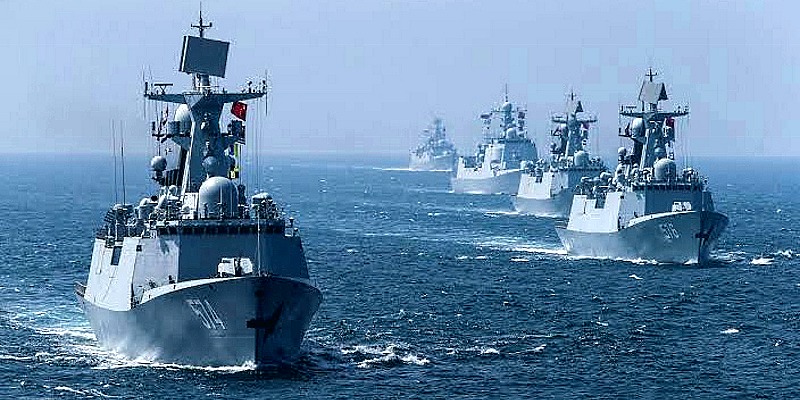While China builds up its diplomatic presence in the Middle East and is perhaps looking forward to brokering a ceasefire deal between Ukraine and Russia, in the South China Sea it has been gradually building strategic advantages that threaten the vital interests of the United States and its allies.
This has been happening over the years when the United States was engaged in Afghanistan, Iraq and other Middle East conflicts.
Today, China has become an important military force in the South China Sea, an area through which trillions of dollars of trade flows every year and is critical to the defense of Taiwan.
China made itself indispensable to the United States in its dealing with North Korea, climate initiative and other global issues.
In fact, China was using North Korea as a weapon to browbeat the United States to soften its stand on other issues.
The United States lowered its guard, overlooked what was happening in the South China Sea, and ignored the fact that China was stealing American intellectual property and spying on its vital trade secrets.
The entire disputed area in the South China Sea, consisting of 250 islands, atolls, shoals, and reefs, including the Paracel and Spratly Islands, is claimed by several countries in the region including the Philippines, Malaysia, Brunei, Vietnam, and Taiwan.
Japan’s geopolitical interest in the region is indisputable. Nevertheless, under the benign umbrella of cooperation with the United States, China kept pursuing its own hegemonic interests in the region.
China has finished the build-up of all the seven Spratly artificial islands with complete military infrastructure, and aircraft hangars, docks, satellite communications, and shelters for missiles and missile platforms, according to reports.
While China was building artificial islands, it went on politely asserting that it had no intention of militarizing the islands.
The region is rich in oil and gas and abundant in fisheries.
China’s build-up in the South China Sea threatens not only the security of American allies including Taiwan, South Korea, Japan, and the Philippines but also poses threat to vital industries such as advanced semiconductors manufactured in Taiwan.
According to American military experts, the strategic advantages that China has made over the years in the region are irreversible.
Only a major conflict could remove China from its firm hold on the regional geography.

In future conflicts, China could interfere with international trade. China has been accusing the United States of interfering in the region implying that the whole region is under its hegemony.
Today, there’s an overwhelming bipartisan consensus in the United States that China is a major security challenge for the country, as it became clear after the spy balloon incident which resulted in heated exchanges between the two countries.
In order to play a global role on the world stage President Xi Jinping has been asserting his power in many ways, militarily, economically, and diplomatically.
On March 10, China shook up the world by announcing that it had brokered a deal between two long bitter rivals in the Middle East, Saudi Arabia and Iran, and brought them together to reopen their embassies which had been closed for seven years, following the execution of a Shia cleric by Saudi Arabia.
This is of course a major diplomatic development that may have a tremendous impact not only upon the leadership role which the United States has been playing in the Middle East but also on Israel’s complicated geopolitical relations in the region.
China is a major trading partner of both Iran and Saudi Arabia. Forty per cent of its oil imports come from the region and no doubt it serves its interest if there’s peace between two rival countries.
Just as China has been building bases in the South China Sea without raising any alarm until recently, it has been trying to do the same thing in the Himalayan region also.
Since its conflict with India in 1962 it has been gradually advancing and craftily building its bases in the Himalayan region and encroaching upon Indian territory in spite of several agreements based on the international boundary and the lines of actual control.
A major conflict took place in 2020 in Galwan Valley in Ladakh during which 20 Indian and four Chinese soldiers were killed.
India knows that an agreement with China does not mean anything if it does not suit China’s interests.
As a revanchist power questioning established historical facts in order to advance its claims, China has been trying to rewrite history.
First, it lays a cartographic claim based upon its own interpretation of history, and afterward, it nibbles small territories, nimbly and incrementally, establishing its presence without raising any alarm; and when its physical position becomes strong and irreversible, then it claims that this is the reality, and the present actualities should be accepted as fait accompli.
China plays a long-term game. Its slow and gradual maneuvers leave its opponents puzzled as to what kind of response would be proportionately adequate.
Whether it is nipping territory in the Himalayas, hill by hill, valley by valley, or it is the reclamation of reefs and atolls in the South China Sea, China’s international conduct has been destabilizing.
While India has yet to find out how to deal with the coercive and deceptive behavior of China, the United States is determined not to allow China to get away with its aggrandizement.
The Indo-Pacific region has become central to US foreign policy, despite Russia’s aggression against Ukraine, which eventually when the war is over, would become integrated with Europe.
Apart from its renewed alliance with the Philippines regarding the establishment of new military bases, and the quadrilateral alliance Quad, including India, Australia, and Japan, President Biden recently signed the AUKUS deal with the United Kingdom and Australia that would enable Australia to build nuclear-powered submarines to face China’s challenge.
China’s aggressive behavior has alienated its neighbors.
In spite of the militarization of the artificial island bases, China has not been able to dominate the region – not at present.
Other regional powers have begun to assert themselves. They have also upgraded their military installations on islands under their control. They have begun to explore oil and gas reserves on their own thereby challenging China’s efforts to control the region totally.
Once again, the United States has become indispensable for free trade and security of the region.
The biggest challenge to China has come from the Philippines. When China took control of the disputed Scarborough Shoals, the Philippines took the case to the International Court of Arbitration, and won the case. But China rejected it.
Its rejection of the international arbitration decision shows that China doesn’t care for the international rule of law when it does not suit its strategic interests.
This however opened the door for the United States to re-establish its security relations with the Philippines resulting in the Enhanced Defense Cooperation (2014) agreement, which was a landmark diplomatic achievement.
Unlike Barack Obama who bent over backward to seek China’s goodwill as a rising global power, Donald Trump totally rejected China’s hegemonic claims on the South China Sea – the policy which the Biden administration has continued with greater vigor and determination and with the full support of Republicans and Democrats.
In the Middle East, China seeks peace, but in the Himalayas and the South China Sea, China has been behaving like a bully.
(Narain Batra is affiliated with the Diplomacy and International Program in the Graduate College at Norwich University, USA. He is the author of several books including the most recent, India In A New Key: Nehru To Modi.)
ADVERTISEMENT
ADVERTISEMENT








































